Fenway Park (13 page)
Authors: John Powers

“I never believed in ‘crying over spilled milk,’” Quinn declared as the campaign was winding down in September with attendance nearly halved. “And there isn’t any use in alibiing a team which has finished last in every department of play.” Only a rainout of the season’s finale with Washington prevented the club from finishing with the worst record in franchise history.
But the bad news didn’t end with the season. In November, the state board of appeals ruled that Quinn had to pay an additional $27,575 in taxes on the club’s profits from the sale of Ruth and Mays to New York.
Since it didn’t seem possible that things could be worse in 1926, even Kenesaw Mountain Landis sensed at least a possibility of improvement. “You seem to have a fine lot of athletes here and I wish you all kinds of luck,” the commissioner of baseball told Quinn at the club’s New Orleans training camp, saying that he’d wager “a golf stick or two” that Boston would pull itself out of the basement.
When the Sox came from 10 runs down in the fifth inning to nearly catch the Yankees on Opening Day in the Fens, it seemed that they might at least quicken heartbeats. “If you are inclined to apoplexy, heart trouble, shocks or faints don’t spend your afternoons at Fenway Park,” the
Globe
’s Ford Sawyer cautioned after the riveting 12-11 loss.
But after the hosts went down, 11-2, to the Indians on May 7, the distress signals were unmistakable. “The Sinking of the Ship. A Farce-Comedy in Nine Acts directed by T. Speaker,” read the
Globe
headline the next morning. A day later, the theater itself was charred by a three-alarm fire that ravaged the third-base bleachers.
The front office, which had far more seats than it needed for a last-place enterprise, simply roped off the area and continued as before. The owner was more concerned about his ramshackle club, which was a far more extensive and expensive renovation project. “We get players who have been highly recommended, and who were desired by other clubs,” said Quinn, “but when we get them they do not seem to hold up for us.”
By Memorial Day, all that his club was holding up was the rest of the league. The Sox were 18½ games behind, en route to their poorest campaign ever (46-107). After they lost their final 14 games, all at home, Quinn was looking for a savior who actually had seen a pennant flying over the premises.
The obvious candidate was Bill Carrigan, the former catcher-manager who’d led the club to its 1915 and 1916 championships. Carrigan, however, was content with his life in Maine and had no desire to return to the dugout. “I shall not get back in the game,” he declared in October after Fohl had resigned. But by December, after visiting with Quinn, Carrigan found himself back on the payroll. “I got talking baseball,” he said, “and before I knew it I was manager of the Red Sox again.”
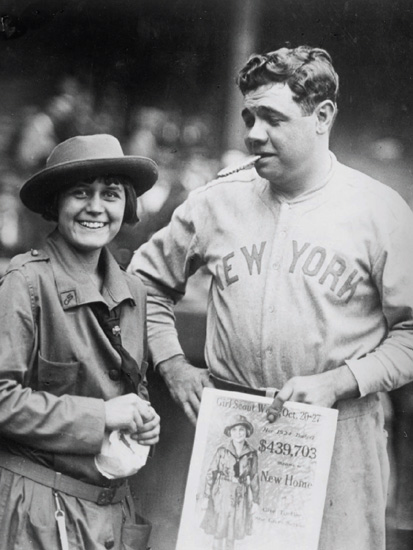
No longer a member of the Red Sox, the Babe still went to bat for some Boston causes, including this Girl Scout Day promotion at Fenway in 1923.
He was, Sawyer wrote, “the Moses who is expected to lead a downcast Boston aggregation out of the wilderness of defeat and disappointment.” But Carrigan would have had a better chance of parting the Charles River than of leading the bedraggled Sox to the first division, much less the promised land. His club, a 50-1 long shot to win the 1927 pennant, was dead on arrival by Opening Day.
The Sox dropped the season’s first game by four runs at Washington, as the skipper “exhorted, wheedled, commanded, coaxed, bullied, and pleaded.” They were swept by the Senators, and then lost three of four games at New York, including a 14-2 blasting. By Labor Day, the only reason to come to the park was to watch Ruth, Lou Gehrig, and the rest of the Yankees’ “Murderer’s Row” launch baseballs skyward. Nearly 35,000 showed up for the doubleheader with New York, the largest Fenway crowd since 1915, with the
Globe
reporting that “other thousands crashed the barriers, broke them down and swept into the grounds.”
So fans were startled to see the Sox outlast the Yankees, 12-11, in the 18-inning opener, with Red Ruffing pitching the first 15 innings for the home side. The game lasted so long—four hours and 20 minutes—that the nightcap had to be shortened to five innings, which were completed in a brisk 55 minutes with New York winning, 5-0. The clubs split another twin bill the next day, with Ruth clouting three homers. The first, which cleared the center-field fence to the right of the flagpole, was deemed the longest hit at Fenway up to that point. “Nobody at the park could tell where it landed,” wrote O’Leary, “but when it disappeared it was headed for the Charles River Basin.”
The Yankees went on to claim the pennant by a whopping 19 games and swept the Pirates in the World Series, as Boston was buried 40 games behind in the cellar. Still, Carrigan was optimistic about his men’s chances for 1928, predicting that they’d be “a better ball club in many ways.” Indeed, the Sox climbed out of the basement amid a May blossoming that had them in fourth place after six home victories in a row. “The time-worn theory that there are only eight basic jokes will have to be revised,” the
New York Post
suggested. “The Boston Red Sox have climbed into the first division in the American League.”
Even Quinn was intrigued by that novelty, announcing that he would spend a million dollars to double-deck the ballpark and increase capacity to more than 52,000—as soon as his club was good enough to make it necessary. Acrophobia and gravity proved a fatal combination, though, and the Sox soon began free falling. Before the end of July they were back at the bottom of the standings and the
Globe
provided an early obituary (“A Sad Decline”) in early September. “On the diamond we produce, instead of a succession of championship teams, a perpetuation of tailenders,” the editorial concluded.
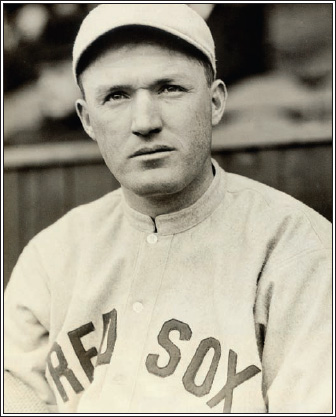
Until Terry Francona duplicated the feat in 2007, Bill Carrigan was the only manager to have won two World Series titles with Boston (in 1915 and 1916). He returned to manage the Red Sox in 1927, but couldn’t do better than last place in each of his three seasons.
After four years of viewing the league from an upside-down perspective, the Sox were justifiably reserved about their prospects for 1929. “I am predicting nothing, but I am hopeful,” Carrigan said before the season. An Opening Day triumph over the Yankees at home was a splendid start, but Boston already was sending out distress signals on May Day when the Athletics dispensed a 24-6 drubbing that at the time set a Fenway record for offense—by the visitors. The
Boston Globe
tallied what it described as “a terrific cyclone of bingles of all descriptions”—29 hits, 44 total bases (11 by Jimmie Foxx), three homers, and six doubles, with 10 Philadelphia runs coming in the sixth inning.
By mid-month, the season already was a lost cause for Boston’s two baseball teams, which both finished eighth in their respective leagues. “In a postseason series between the Braves and the Red Sox, which would win?” the
Globe
mused in October. “Don’t you mean post-mortem series?” retorted the
Brockton Enterprise
.
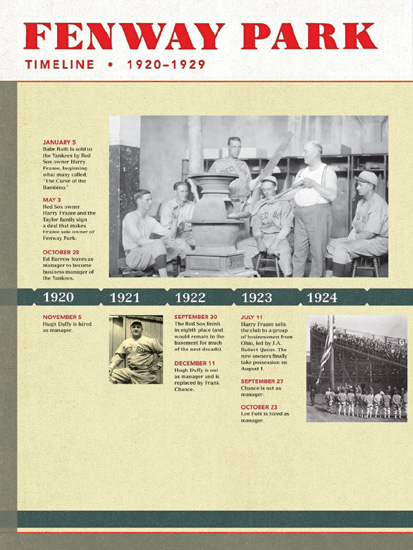
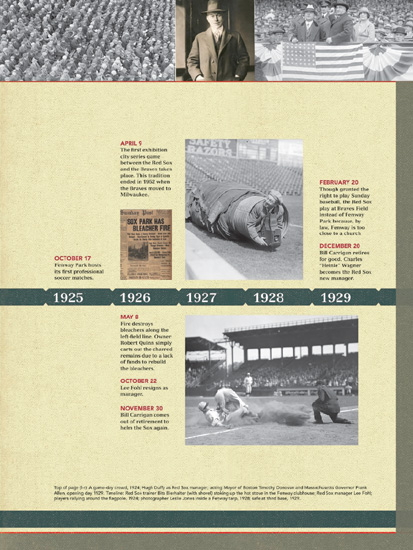
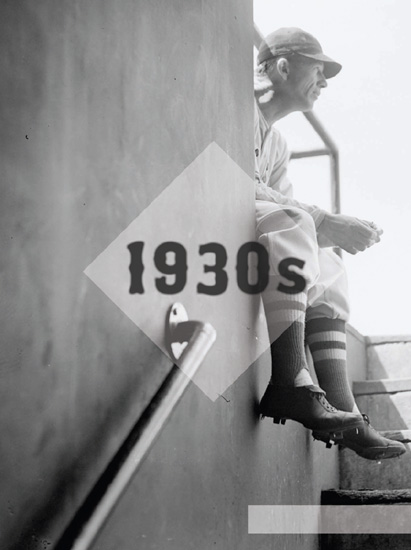
Lefty Grove, who won 105 games for the Red Sox between 1934 and 1941, watches the action from the dugout.
B
y the time the 1930s were in the rearview mirror, Fenway Park itself and its major inhabitants had undergone a transformation. The team and the ballpark got a new owner in 1933, and the Red Sox made a slow climb from being cellar dwellers in nine out of 11 seasons through 1932 to a pair of second-place finishes in 1938-39. This effort was no doubt helped along by Tom Yawkey’s inclination to spend his considerable wealth on players he thought could help. The park itself also benefited from the infusion of Yawkey’s cash and enthusiasm. Although a five-alarm fire undid many of the off-season renovations that had cost nearly $1 million to complete by January 1934, Sox General Manager Eddie Collins vowed that the team would still open the season in a retooled Fenway. It required a massive additional commitment of money and manpower, but Collins was correct. For probably the first time, the Red Sox attempted to tailor their home field to take advantage of the presence of a slugger. Rookie Ted Williams had hit .327 with 31 home runs and an amazing 145 RBI in 1939. So bullpens were constructed in right and right-center field during the next off-season, with the expectation that Williams would be able to reach the seats (or at least the bullpens) more often en route to a potential Triple Crown-winning season. Williams, feeling the weight of expectation, hit fewer homers in 1940, and his on-again, off-again relationship with fans—and his open feud with newspaper writers—hit a significant rough patch. “There were 49 million newspapers in Boston, from the
Globe
to the
Brookline Something-or-Other
, all ready to jump us,” said Ted years later. Indeed, it must have seemed that way. The Boston Braves (later Redskins) of the National Football League debuted in this decade, but the NFL failed to rouse enough local support, so the Redskins left for Washington after the 1936 season.
